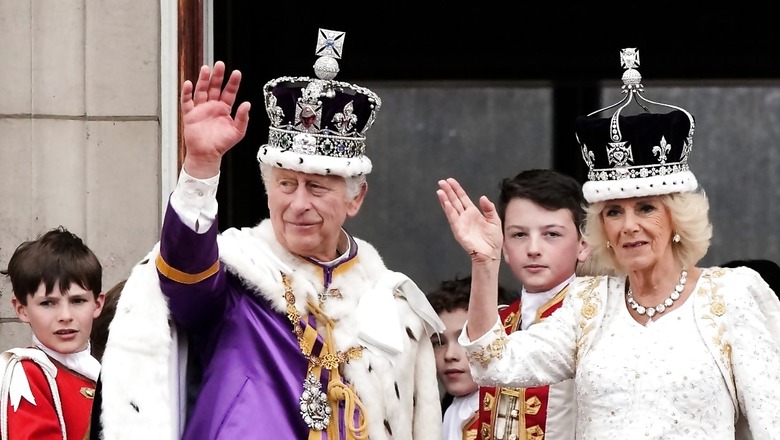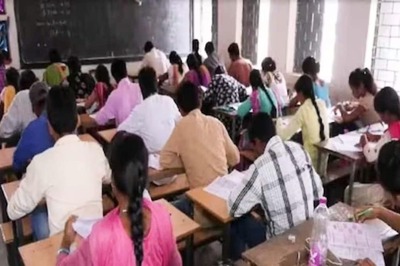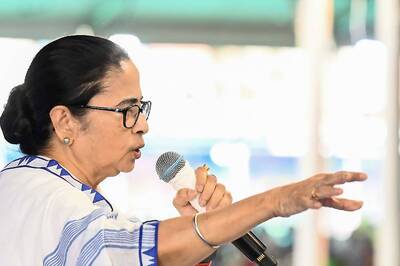
views
This is a two-part essay on how the principle of “His Majesty’s Loyal Opposition” not only saved the monarchy in the land of the “Mother of Parliaments” but also fostered the freedom movement in India on civilian lines.
It was after a gap of 70 years that Britain witnessed the coronation of any monarch. Queen Elizabeth II, mother and predecessor of King Charles III, had been crowned at Westminster Abbey on June 2, 1953. In 1951, King Farouk of Egypt had told Lord Boyd-Orr in Cairo that there would be soon only five kings left — the Kings of England, Diamond, Hearts, Spades and Clubs. It is speculative whether the tenth and last ruler of the famous Muhammad Ali dynasty had a premonition of his exile or he was a dispassionate observer of global politics in the post-World War II era. Farouk was overthrown in a bloodless coup on July 26, 1952, carried out by the Free Officers of the Egyptian Army led by Gamel Abdel Nasser.
Kingsley Martin, writing in 1962, finds monarchy in Britain “uniquely popular and secure.” Outside Europe, the type of revolution that made Farouk a fugitive had become everyday news. In Europe, there were six monarchies left, including in Greece, which was abolished a decade later. Martin, however, distinguishes the British monarchy from monarchies in Scandinavian nations, whose titular heads were merely “hereditary presidents.” Those royals go out shopping like other mortals, without being “mobbed by sightseers or surrounded by photographers” (The Crown and the Establishment, P.15). The craze for the British royalty has not abated even six decades later. It was proven in a fatal extreme in 1997 when the paparazzi, hounding a former member of the British royal family — on foreign soil — led to the death of Princess Diana in a car crash.
Walter Bagehot (1867), writing in Victorian England, tried to explain the popularity of the monarchy for commoners. “If you ask the immense majority of the Queen’s subjects by what right she rules”, says Bagehot, “they would never tell you that she rules by Parliamentary right, by virtue of 6 Anne, c.7. They will say she rules by the ‘God’s Grace’; they believe they have a mystic obligation to obey her” (The English Constitution, P.42-43). The Victorian era was an epoch of rationality, the discoveries of Darwin, an extension of the Parliamentary franchise, increasing Parliamentary proceedings, the industrial revolution and increasing complexity of bureaucracy. Yet, the mystique of monarchy defied logic.
Logic might still be on the side of Graham Smith, the anti-monarchist. In his upcoming book ‘Abolish the Monarchy: Why we should and how we will’ (Penguin Books), Smith claims there is not a single valid argument in favour of the continuance of monarchy except uncritical tradition. Yet, what is saving monarchy from extinction in Britain?
God, in the British tradition, saves the king. However, the preservation of “Kingship” in Britain in the 21st century might appear as a historic miracle. The Communist Manifesto, co-authored by Karl Marx and Friedrich Engels, was originally published in London (1848), in the same year when French, German, and Hungarian revolutions inspired hopes of republican success in the continent. Subsequently, World War I swept away the monarchies in Germany, Austria, Russia and Turkey. “Why has the British monarchy survived as a symbol of unity beyond all parties”, asks Peter Viereck (1962), “while the monarchies of Russia, Austria, and Germany were violently overthrown?” He finds the answer in the very British concept of “His Majesty’s Loyal Opposition.” “Perhaps because England, like the Dutch, Belgian, and Scandinavian monarchies, made a special point to distinguish between violent and lawful opposition. The east, above all the tsardom, could not conceive of such a seeming contradiction as ‘His Majesty’s loyal opposition’, a concept basic to the conservative idea of freedom” (Conservatism Revisited, P.37).
Recently, Graham Smith’s example only confirms the same. His book is being published by a leading British publisher viz. Penguin Books. The leader of the Republican movement was arrested only when he tried to ‘disrupt’ the coronation event and thereafter released within hours. Imagine what would have happened if he had tried to campaign for the abolition of monarchy in Saudi Arabia, Jordan, or Morocco! In June 2021, he had participated in Oxford Union Debate on the motion “This House would abolish the monarchy.” Imagine, Oxford Union holding such a debate in the UK, and none are being charged for sedition. Such an elastic definition of ‘His Majesty’s loyal opposition’ has been the monarchy’s “saving grace”, Smith will agree.
II
Those who oppose monarchy in Britain at present are not anarchists or revolutionary but Democrats. The astonishing part of the survival of monarchy in Britain is that it has not been consumed by the Parliament. Survival of the institution of monarchy in the land of the “Mother of Parliament” might appear paradoxical to Indians. To create a democratic republic in India, Sardar Patel had to sweep away 562 crowned heads of princely states. The Indian dominion, successor state of British India, formed the core of the Indian Republic. Even though “Indian India”, as Harcourt Butler had described the princely states, commanded 48 percent territory and 27 percent population, they had to acquiesce to merge into the Indian domain (vide White Paper on Indian States, Govt of India, 1948, P.3)
Admittedly, the Constituent Assembly did not conceive of compulsory abolition of the princely states. Jawaharlal Nehru, while moving the ‘Objective Resolution’ on December 13, 1946, left the matter to the people of the respective states- The Resolution does not concern itself with what form of government they will have or whether the present Rajas and Nawabs will continue or not. These things concern the people of the States. It is quite possible that people may like to have their Rajas. The decision will rest with them. Our republic shall include the whole of India. If a part within it desires to have own type of administration, it will have the liberty to have it.
However, as things progressed, constitutions within Constitution were found untenable. British left few choices for the princely states upon the lapse of paramountcy. They had to negotiate to merge with one of the two dominions viz. India and Pakistan, where the choice was critically restricted by geography. It was Harekrushna Mahtab, the then Premier of Orissa (now Odisha), who showed the way to cut Gordon’s knot as India gained independence. His ‘police action’ on Nilgiri, a tiny princely state, near Balasore on November 14, 1947, aimed at integrating it with the Orissa administration sent out a stern message. The story is excellently told in his book ‘Beginning of the End’ (1949), with a Foreword by Sardar Patel, who built upon the bold action of Mahtab to integrate India by coercion, if necessary. The crowned heads of India had to completely go to make way for the Republic. The unity of India was provided by Parliament, with an elected President serving as the executive and legislative head.
The princely states in India had to disappear not merely for the sake of forging a united India as a democratic republic. They had long become an anachronism by refusal to carry out requisite political reforms. Out of 562 princely states, not more than 60 had some kind of representative bodies even to associate their subjects. Except for Mysore, Travancore and Cochin, constitutional progress was uninspiring. Hyderabad, the largest of the princely states, had the gall to repeal its Legislative Assembly A’in (Charter of Legislative Assembly of the State) through Nizam’s firming in December 1948. In Tripura, the constitutional reforms envisaged as late as 1943, by creating a unicameral assembly with rudimentary powers, were trivial at best.
The official narrative of the freedom movement focuses on the struggle against colonial rule in British India. The popular movements in various princely states against their maladministration are left out in the shadows. One of the glaring aspects of the revenue administration in the princely states was the absence of a privy purse, implying no demarcation between the ruler’s personal income and income of the state. While the Political Department, Government of India, says historian and R.L. Handa (1968), repeatedly instructed the princely states to separate the privy purses of the rules from the state revenue, they indulged in eye wash. In a state like Bikaner, for example, Maharaja’s privy purse was fixed at Rs 25 lakh, which was more than one-fourth of the state’s revenue (History of Freedom Struggle in Princely States, P.42)
Popular movements had crystallized in the princely states by the 1920s. As evident from the resolutions at All India States’ People’s Conference at Bombay on April 17 and 18, 1927, the advanced section of subjects in princely states demanded representative institutions on an elective basis for the purpose of legislation & taxation etc, separation of state revenue from the personal budget of the rulers, establishment of an independent judiciary etc. Later that year, the All India States’ Subjects’ Conference was held in Madras (December 26-27, 1927) ahead of the annual Congress session in the city. S. Satyamurthy, Member of Legislative Council, Madras Presidency who himself hailed from the princely state of Pudukottah, emphasized that none can build a China wall between British India and the Indian States. “Swaraj for British India is bound to come and the new awakening in British India cannot but affect deeply the people of Indian States”.
This reveals something more than the fact that British India was more progressive than “Indian India”. It reveals why the days of monarchy in India were numbered, unlike the British monarchy. Medieval India, before the advent of the British, could boast of no political reforms on the lines of Europe. “The history of Mohammedan Period” observed Stanley Lane-Poole, “is therefore necessarily more a chronicle of kings and courts and conquests than of organic or national growth” (Medieval India under Mohammedan Rule AD 712-1764, P.iv). In Europe, modernity in politics evolved from medievalism, in India, it had to be introduced by the British.
III
The British monarchy, at best, could be accused of being an expensive superfluity. It has, however, not been a positive impediment to the growth of constitutionalist ideas. It has survived by giving up powers in stages, especially in the 17th century when a constitutional monarchy was established as a result of the Glorious Revolution (1688). One of the more recent examples was the Fixed-term Parliament Act, 2011 which made the dissolution of Parliament governed wholly by statutory rules rather than simple royal proclamation as per the convention. The Dissolution and Calling of Parliament Act, 2022 includes a provision to make it “exercisable again as if Fixed-term Parliaments Act, 2011 had never been enacted” (House of Commons Research Briefing, The Crown and the Constitution, 2023, P.8). However, there is little doubt that a British monarch will always act on aid and advice of his council of ministers.
This is the first of the two-part series. The second and last part will deal with how the principle of His Majesty’s Loyal Opposition led to fostering of a freedom movement on civilian lines in British India, culminating in India becoming the world’s largest democracy.
The writer is author of the book “The Microphone Men: How Orators Created a Modern India” (2019) and an independent researcher based in New Delhi. The views expressed herein are his personal.



















Comments
0 comment